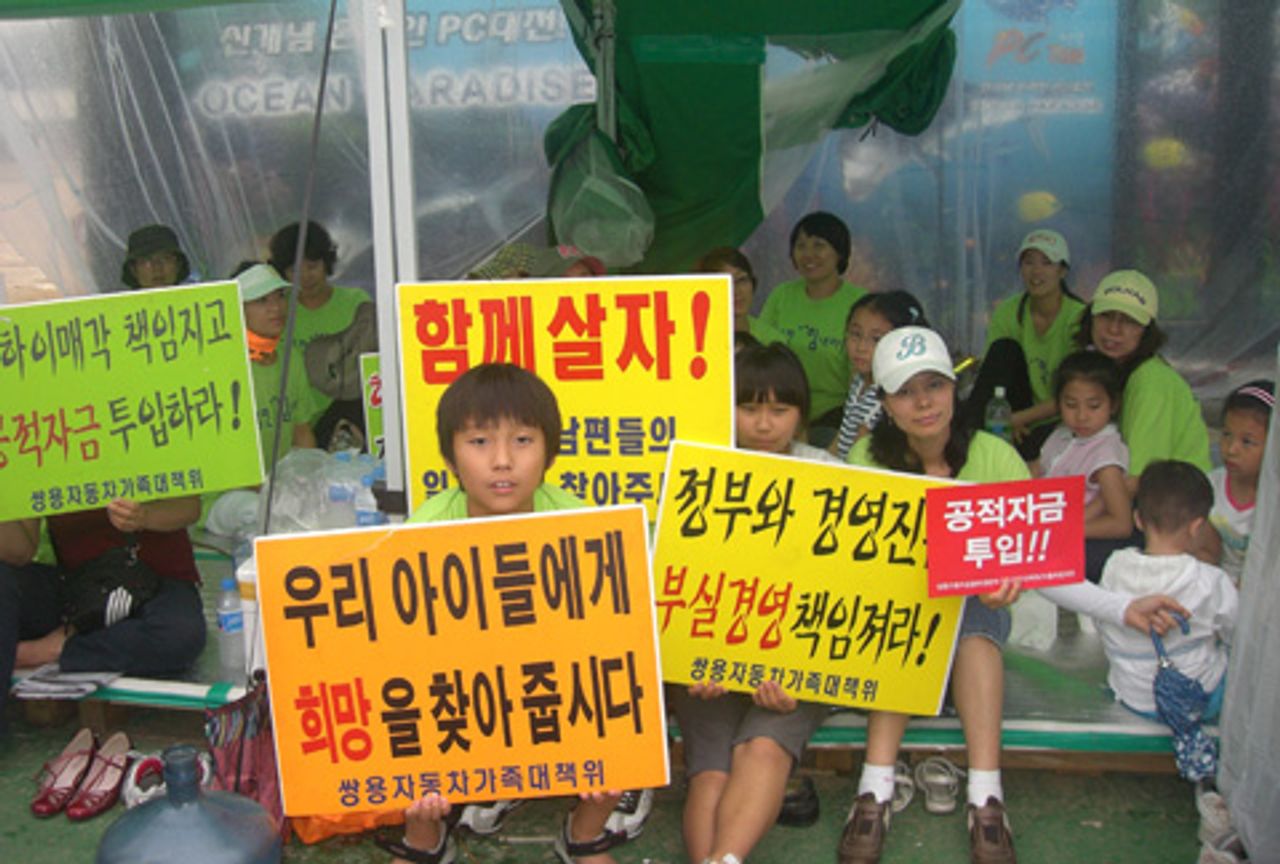President Lee Myung-bak’s government has stepped-up preparations for a police assault aimed at breaking an eight-week occupation by around 1,000 workers at Ssangyong Motor’s Pyeongtaek plant in South Korea. The occupation began on May 22 when the management announced 2,646 layoffs, around 36 percent of its total workforce, as part of a court-supervised restructuring plan to meet the demands of creditors.
Last weekend, police moved in with forklifts to remove containers and other barriers from the plant’s four entrances. Workers had erected the barricades following a failed assault at the end of June by hundreds of company-hired thugs and non-striking workers backed by around 500 riot police.
Police have also built fences and checkpoints inside the gates and increased the number of officers around the plant. Two workers who attempted to resist the demolition of the barricades were arrested, as were a number of supporters demonstrating peacefully outside the plant.
A management spokesman admitted that the police had taken aerial surveillance photos of the plant to locate the whereabouts of the workers inside. A police spokesman told the media on Sunday: “In preparation for the crackdown, we’ve secured the gates.” Another police officer said: “We plan to gain full control of the plant and forcefully disperse the workers.”
 Ssangyong occupation supporters call for public funds to save jobs
Ssangyong occupation supporters call for public funds to save jobsOnly a small number of people—members of the workers’ families, some students and other supporters—are outside the plant. They have not been mobilised by the major unions but by the Ssangyong Joint Struggle Headquarters, a workers’ committee.
Over the weekend, the committee issued statements condemning the police preparations and arrests and demanding that the union covering the occupying workers, the Korean Metal Workers Union (KMWU) and its peak body, the Korean Council of Trade Unions (KCTU) immediately act on a promise to call a general strike if the government and employers moved to smash the occupation.
At a rally on July 4, KCTU chairman Jeong Jin-hoo urged the government not to “exacerbate the situation” by taking offensive action against the occupation and pledged to lead a general strike from “the very front with flags” if the government did so. That vow was so much hot air. Despite the advanced police preparations now underway, neither the KMWU nor the KCTU have mobilised any of their tens of thousands of members to back the occupation.
Since the occupation began, the unions have isolated it, restricting support to small protests outside the plant. When police and management thugs attacked the plant at the end of June, the occupiers were left to fight on their own.
The KMWU is working behind the scenes to end the occupation, appealing to the government and the company to put the layoffs on hold and accept cost-saving concessions. These include work sharing, short-time working and other measures that would drastically reduce workers’ wages. The union is asking for the company to be transformed into a public entity under the state-controlled Korea Development Bank, a major shareholder.
But the bank, together with China’s Shanghai Automotive Industry Corp, which owns 51 percent of the company, has been instrumental in pushing it into bankruptcy to impose the restructuring now underway and raise new loans worth 250 billion won ($US199.5 million). Creditors have warned that failure to carry through the restructuring and layoffs will result in liquidation.
For two decades, the KCTU and KMWU have played a pivotal role in imposing the demands of the banks and big business by isolating and betraying struggles throughout key industries, including auto, heavy engineering and transport.
If the company and government are allowed to defeat the Ssangyong workers it will embolden employers across all sectors to drive through a restructuring designed to offload the cost of the global capitalist crisis onto the backs of working people.
The struggle must be taken out of the hands of the unions, workers must rally independently to defend the occupation, and rank and file committees must be constructed in every workplace to mobilise the active support of the working class in Korea and internationally. Above all, this means fighting for an international socialist perspective that rejects the demands of the corporate elite and aims to reorganise society as a whole on the basis of social need, not private profit.
The author also recommends:
Ssangyong occupation supporters speak to the WSWS
[July 16 2009]
Subscribe to the IWA-RFC Newsletter
Get email updates on workers’ struggles and a global perspective from the International Workers Alliance of Rank-and-File Committees.
